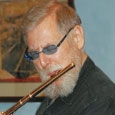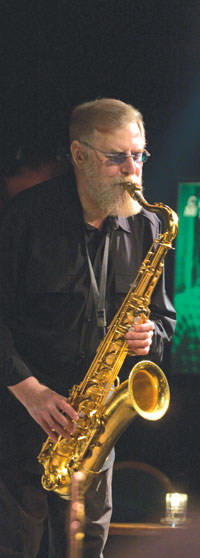 Lew Tabackin is a jazz legend on two instruments, flute and tenor saxophone. He is not a doubler – instead he plays two distinct primary instruments. His flute renditions are not merely a melodious version of what he might have improvised on sax, and his sax offerings differ from his flute style.
Lew Tabackin is a jazz legend on two instruments, flute and tenor saxophone. He is not a doubler – instead he plays two distinct primary instruments. His flute renditions are not merely a melodious version of what he might have improvised on sax, and his sax offerings differ from his flute style.
Acquainted with his recordings with The Toshiko Akiyoshi – Lew Tabackin Big Band for the past 30 years, I was excited about interviewing Lew Tabackin last August at the National Flute Association convention in New York.
A Dubious Early Music Education
Tabackin grew up in a non-musical family in south Philadelphia. “I don’t know where the music came from,” he said. “It’s very strange. I was always jealous of people who grew up in musical families; they get a head start. I didn’t, so it took me longer.
“I was in school and wanted to play something in the band. I had no great desire for any particular instrument, but I thought it would be nice to play. Actually, it was the clarinet that appealed to me. We didn’t have any money to buy an instrument, so I was at the mercy of the school system. The only thing they had was a flute, and three people wanted to play it. The person who could produce a sound would be selected to receive the flute. One guy got a sound right away, and I got sort of a half sound. The third person couldn’t produce anything at all. The boy who got a decent sound decided that he didn’t want the flute, so that’s how I came to play the instrument.
“The good news was that I got the flute. The bad news was that they gave me free lessons from a guy who came to the school and didn’t know anything about flute. Picture a student playing flute with the headjoint end of the flute resting on his left shoulder. That’s what I did, and the teacher never said anything. The only B-flat fingering I knew was the one with the left thumb. I had every bad habit imaginable. When I finally decided that I wanted to learn to play correctly, it took me years and years to correct all of those bad habits. It really makes you realize the importance of getting a good start, which I certainly did not have.
“I graduated from high school and still didn’t own a flute of my own. The director let me keep the school’s flute until I could afford to buy one. I was playing in this big band a bit later, and a bass trombone player, of all people, had a hand-made, closed-hole Haynes that he sold to me for $300.”
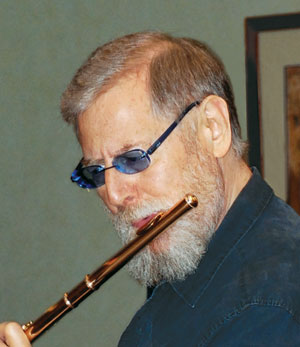 Tabackin had a few lessons with John Krell at the Settlement School in Philadelphia but uses the word horrendous to describe how bad he was, although he admits that he played well enough to be accepted into the All-City Orchestra. Members of that group received scholarships to the Philadelphia Conservatory, which later became the Music Academy. “At that time I was already into jazz saxophone, so I didn’t really want to take flute lessons. However, there was no saxophone program at the Conservatory, so I took flute lessons. My last year there I studied with James Pellerite, who came in to replace Kincaid when he retired.”
Tabackin had a few lessons with John Krell at the Settlement School in Philadelphia but uses the word horrendous to describe how bad he was, although he admits that he played well enough to be accepted into the All-City Orchestra. Members of that group received scholarships to the Philadelphia Conservatory, which later became the Music Academy. “At that time I was already into jazz saxophone, so I didn’t really want to take flute lessons. However, there was no saxophone program at the Conservatory, so I took flute lessons. My last year there I studied with James Pellerite, who came in to replace Kincaid when he retired.”
Tabackin also studied with Murray Panitz for one year, and says, “A magical thing happened. Murray showed me the most fundamental thing – something that I had not known before; he taught me about the overtone series. It was a revelation. His approach required a flexible jaw, to be free enough to move and allow maximum flexibility for intervallic execution. I went from the worst flute player in the history of flute playing to achieving a respectable tone. Murray must have thought he was a teaching genius because I began to improve so quickly.”
Tabackin was 23 when he was drafted into the army. He left Philadelphia for the first time, went into the army for two years, and in his words, “never looked back. After the army I moved to New York, where I lived from 1965 to 1972. Then I moved to Los Angeles for 10 years.” While in Los Angeles Tabackin did some session work. “I didn’t tell them that I played the saxophone. Flute was a challenge, because you had to play in tune with the violins, learn to play really sharp, you know, ‘You’re sharp or you’re out of tune.’ I found it to be a challenge, but it really wasn’t what I wanted to do. I played on the Tonight Show for about four years, but I am not cut out for commercial music. I don’t play a bunch of saxophones, and I had to play a little self-defense clarinet. It did, however, pay the rent and support my jazz career.”
Eventually Tabackin came back to New York and has been there ever since. During this period he was playing both flute and saxophone. As his flute tone continued to improve he found that “jazz flute didn’t seem to work for me anymore. So I proceeded to listen to Murray Panitz for a solution to the problem. After graduation I had started working on my own, keeping Murray’s overtone series idea but also listening to recordings by other Classical players including Rampal, Julius Baker, and Kincaid. I loved Kincaid. I heard him from back stage with the Philadelphia Orchestra and attended his farewell recital; it was amazing. His sound was awesome. The point of all of the listening was an attempt to find a sound that I could relate to.”
Tone and Style for Flute
Tabackin explained that his quest for a workable jazz flute sound related to what he was playing on saxophone. “The tenor sax has this great, unbelievable jazz heritage, but the flute doesn’t have anything comparable. I felt like – I play a certain way on the saxophone, why try to play the same way on flute? The flute is another animal. It sounds completely different, so why should the music sound the same. It should be different too, so I pursued the concept of different sounds and personalities for the two instruments.” He cut a long-playing recording, Dual Nature, with one side on flute and the other on saxophone. “The two sides had completely different personalities – people could actually hear that one person was doing two different things. In fact, some people couldn’t believe that I was playing both instruments.
“Sometimes I used a more French Impressionistic approach to harmonies and improvisations on flute. I was and still am very careful about what music I chose to use for jazz flute. I look for music that is more flutistic; it is usually narrative and inspired by the sound.
“Frank Wess is key if you want to talk about jazz flute. He set the standard by playing with great instrumental and musical integrity, but he’s one of the few. The upside of jazz flute is that, when there isn’t a long-standing tradition, you can make your own. That’s what I did. It’s hard to do on the saxophone; the best you can hope to do is create a very personal approach and expand the tradition. On the flute I was determined to find my own way, whether people liked it or not.
“I think I am kind of a narrative player. I grew up in the early 1960s, a period in jazz when players didn’t just play chord changes, but perhaps related what they were doing to a painting, poem, or story. This is a valuable improvisational technique that they don’t teach in the educational system today. I try to tell a story. Sometimes I’m successful and sometimes I’m not, but I give it a shot.
“For example, one time I was hired to play music for a television cops and robbers series. I hadn’t been in New York very long and generally didn’t do commercial work. There was a famous studio musician, a wonderful player, Harvey Estrin, who got me the gig. It turned out that the composer had written a kind of 12-tone theme, and I just improvised on it for about 15 minutes. They used little sections of it throughout the whole series, but unfortunately I only got paid once.”
Sound is Essential
Toshiko Akioshi, a Japanese/American pianist and composer, and Tabackin were married in 1969. In 1973 they formed the 16-piece Toshiko Akiyoshi – Lew Tabackin Big Band, for which Akiyoshi arranged all of the music. 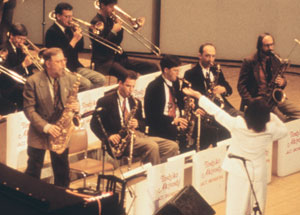 “Toshiko started writing music, and I always asked for a story because I didn’t want to just play; I wanted to tell the story. Her music was often Japanese-inspired, so I learned about shakuhachi music, which I found had a naturally inspiring, sort of zen sensibility. The shakuhachi has just eight notes, so you have to learn to play one note in a lot of ways. I experimented with those concepts on the flute and found that, in the right environment, I could sort of hypnotize myself. You play one note – a little differently – a little differently – a little differently, and all of a sudden you are playing in a totally non-thinking place. It is an interesting experience when it happens.”
“Toshiko started writing music, and I always asked for a story because I didn’t want to just play; I wanted to tell the story. Her music was often Japanese-inspired, so I learned about shakuhachi music, which I found had a naturally inspiring, sort of zen sensibility. The shakuhachi has just eight notes, so you have to learn to play one note in a lot of ways. I experimented with those concepts on the flute and found that, in the right environment, I could sort of hypnotize myself. You play one note – a little differently – a little differently – a little differently, and all of a sudden you are playing in a totally non-thinking place. It is an interesting experience when it happens.”
When asked if he would call himself a doubler, he responded strongly: “No. What I do is almost impossible in a sense. I have two primary instruments that I deal with in musically different ways.” He refers to his tenor sax playing as “hard. I don’t use a microphone. My sax setup (mouthpiece/reed, etc.) is pretty heavy, because that is the sound that I hear. I basically set myself up to fail because there is no way to play the tenor sax the way I do and keep my sound at 100% on the flute, but I try. I do the best I can.
“It seems that there is a controversy about me out there. Some people don’t think I’m a jazz flute player, and the classical people don’t claim me either. I’m probably closer to a classical than a jazz sound. It’s just my own sound. Sound changes a bit according to what you are playing anyway. There is more than one way to play a note. Most sax players have a very small tonal range within which they play.
“I was part of a panel once about great sax players, and someone came up with the term tonal virtuosity. When people think of virtuosity, they usually think of fingers, but what about someone who has an incredible sound and ways to deal with the sound, and expresses a lot through that sound? I tell people I can play one note and almost tell a story. There is the time and the phrase and romance and anger – there are all kinds of emotions you can put into a note.
“Tone is the key. When you pick up the flute and it sounds good, then you can play. If it doesn’t sound good, then, go back to the drawing board. When sound doesn’t work, nothing works on the
flute or any other wind instrument, for that matter. One thing I find is that if I don’t get enough sleep, my flute sound suffers.”
Recent Developments
Tabackin was ill for almost all of 2008. When he began playing again, he found that he had lost tone and control. “I set a pretty high standard for myself, and I knew I would have to either give up the flute or work to get it back to where it had been before I got sick. One day I was walking down the street and stopped in at The Flute Centre, thinking I would try some instruments. I hadn’t been there before. My first time there I met Sergio Pallotelli, who is now a friend. He had a concert coming up and I went. Then a Brazilian guy, Toninio Carrasqueira came in, a sort of fan of mine, and I went to his concert. Then I heard Stefan Ragnar Höskuldsson, principal flutist at the Met, and next I heard my friend Jim Walker play. I started listening to all these people and my brain started to move back toward the flute world.
“I began to practice again and became determined to recover what I had lost. You invest so much time in years and in blood, sweat, and tears, you don’t want to lose it. That’s what I went through last year. I was embarrassed to play, but I started to get my flute chops back and began feeling better about my sound. It’s been pretty good since then. 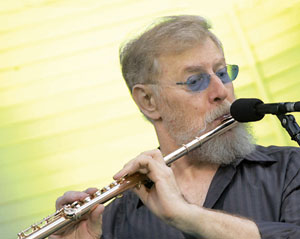
“There are times that I want the instrument to explode in my hands. Nowadays they make flutes that do that a bit more. I just have to choose material that allows me to express what’s inside. I prefer to play without a microphone when possible, but the concert I’m playing here on Saturday might require amplification, especially for the alto flute, since I will be performing with a trio including a drummer. I choose music that has space – harmonies not always changing every bar – so I can develop a line to try to tell that story.”
Improvisation
“I had a Facebook chat with Paula Robison once. I had been to a couple of her concerts, and she is amazing. She wrote, ‘I wish I could improvise.’ My reaction to that was that improvising is just playing one note at a time. You play one note and sound a certain way, and move on to another note, and two to three notes later you have a phrase. Then you develop that phrase. In a way it is easy until you try to get into stylistic realities.
“I saw a film of James Galway trying to play the blues, and I wanted to tell him to tell the story. Great stuff would have come out. I can hear what I would like others to do or rather what they might do if they weren’t so uptight. I went to a Rampal masterclass once. He said that he knew that cadenzas should be improvised, and sometimes he actually planned to do so, but then he usually copped out in the end.
“As a player you have to decide to spend time with yourself and allow accidental music to happen. When I was young, I used to practice all day. I had a closet, and after hours of practice I’d go into it, and just play my tenor, going nuts, allowing all the overtones, and altissimo to explode. After a while you start to get to control it a bit, and it isn’t accidental anymore.
“Approaching improvisation you come up with one motif and then respond to that motif; now you have a conversation going. You play a phrase and then something that relates to the phrase. It’s sort of like playing a duet with yourself. I try to be fairly relaxed when I play. I don’t like to use a lot of tension. When I see a player really grab the flute tightly, it makes me uncomfortable. Julius Baker was the total opposite – it didn’t look like he was playing at all.
“A friend of mine, Allen Cox, used to loan me CDs of classical flutists like Patrick Gallois. There’s a lot of expression happening there – it’s not just notes. Now we hear all sorts of players with varying intensities and colors. The flute world is amazing.”
About Air and The Process
When asked about the difference between air usage on flute (no resistance) and saxophone (lots of resistance), Tabackin replied, “I think about that a lot. What I try to do is use flute technique on the saxophone.” Interestingly, he applies flute practice techniques and air use to the saxophone, by using the Moyse long tone exercise when he practices sax. “I heard a certain sound that I wanted to get on 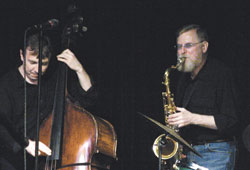 the tenor saxophone. The low register on a tenor is usually pretty rough. I wanted to get the volume but not necessarily the crudeness, so I used the Moyse exercise on the lower notes of the tenor sax, but without any jaw pressure – just warm air – playing that exercise all the way to the bottom of the range. When you first start doing it, it feels like you are doing sit-ups. That’s what I used to improve the low register, which in turn creates a better result throughout the entire instrument.”
the tenor saxophone. The low register on a tenor is usually pretty rough. I wanted to get the volume but not necessarily the crudeness, so I used the Moyse exercise on the lower notes of the tenor sax, but without any jaw pressure – just warm air – playing that exercise all the way to the bottom of the range. When you first start doing it, it feels like you are doing sit-ups. That’s what I used to improve the low register, which in turn creates a better result throughout the entire instrument.”
He also plays alto flute and admits that he likes “the size of the sound and that it allows me to be a bit more beboppy.” He rarely plays piccolo, however, and comments, “Not, if I can help it! My wife writes some piccolo parts in her band pieces, and I use it there sometimes, but basically concentrate on flute and tenor saxophone.”
I asked if he had any parting words and his response was perfect: “Playing is a process – you are never a musician, flutist, jazz musician, or whatever. You are in the process of becoming one; your entire life is this constant journey. You know you can’t win but you sure can try.”
